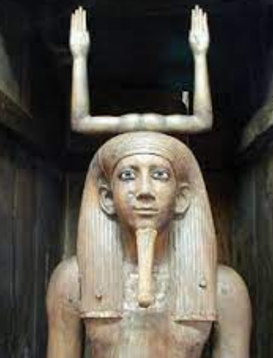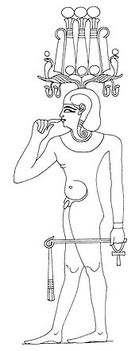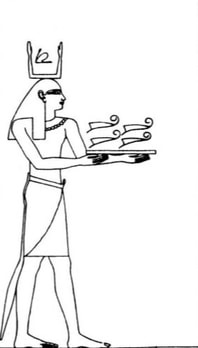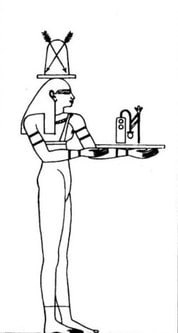Per-Ḥekau
𓎛𓂓OK 𓎛𓂓𓏥OK 𓎛𓂓𓇋𓇋𓏜𓀭MK 𓎛𓂓𓏛𓏪𓀭 𓎛𓂓𓄿𓅱𓀭NK 𓎛𓂓𓄿𓅱𓀁𓀭NK
𓄖𓊾NK
MDC: HkAw
Gardiner: ḤkꜢw
Budge: Ḥekau
Transliteration:
Coptic: Hik /ϩⲓⲕ
Hebrew:
Greek: Eka Ἑκά
Demotic:
Arabic:
English: Heka
Kemetic: Heka
Alt: Hike
Pronounced: Ḥika or Ḥikau
IPA : ħɛkɑ (modern Egyptological)
Meaning: activation of the 𓂓 Ka 'magic'
Home:
Temple: Iunyt/ Esna/ Latopolis; wnnt Khmunu/ Hermopolisin the Nile Delta lands of Lower Egypt
𓉗𓎛𓂓𓊖 shrine
Nome: 3rd Nome Upper Egypt Iunyt/ Esna/ Latopolis other names Iunyt, Ta-senet
15th Nome Upper Egypt wnnt, Khemenu/ Hermopolis Magna
Consort
Hekat
Children
Father
Atum
Khenmu (creator of the bA)
Mother
Alternate Parents
Khnemu/ Khnum (father) and Menhit (mother) (Khnemu as the one who puts the Ka into the human body)
Atum (Father) and Nit/ Neith (Mother) In Esna (Latopolis)
Siblings
Priest names
Hm HkA
Hm nTr HkA
Features
Wears Hemhem Crown or the symbol of Heka on his head with and ankh, flail and scepter. He is either depicted as a child with all the symbology or an adult god. Heka is created at the beginning of time by the creator Atum "before duality had yet come into being", Part of the Esna /Latopolis Triad Nit/ Neith, Khnemu/Khnum, Heka. Heka was said to have fought two snakes and defeated both. This is why pictorial representations of Heka show how he strangles two wounded snakes. Medicine and the activity of healers were regarded as a form of magic, so that the priesthood of the Heka dealt with medicine and healing rituals. Perhaps leading to the idea of the caduceus symbol ☤ pre Hermes.
Symbols
snakes
caduceus ☤
flail
scepter
ankh
Ka 𓂓
HkA 𓄖𓊾
Roles
God of magic and medicine. Heka fought two snakes, evil spirits on the bow of Rā boat which became a symbol of his power. One of the members of the fourteen creative powers of Amun-Rā
Hybrid gods
Heka-pa-khered 'Heka the child' (son of Khenmu and Meḥit in Esna)
Connection to other gods
Hmwst HkA (female counter part)
Hermes (Greek)
Celebrations
Offering items
Protects
Other names
Epitaphs
Temple: Iunyt/ Esna/ Latopolis; wnnt Khmunu/ Hermopolisin the Nile Delta lands of Lower Egypt
𓉗𓎛𓂓𓊖 shrine
Nome: 3rd Nome Upper Egypt Iunyt/ Esna/ Latopolis other names Iunyt, Ta-senet
15th Nome Upper Egypt wnnt, Khemenu/ Hermopolis Magna
Consort
Hekat
Children
Father
Atum
Khenmu (creator of the bA)
Mother
Alternate Parents
Khnemu/ Khnum (father) and Menhit (mother) (Khnemu as the one who puts the Ka into the human body)
Atum (Father) and Nit/ Neith (Mother) In Esna (Latopolis)
Siblings
Priest names
Hm HkA
Hm nTr HkA
Features
Wears Hemhem Crown or the symbol of Heka on his head with and ankh, flail and scepter. He is either depicted as a child with all the symbology or an adult god. Heka is created at the beginning of time by the creator Atum "before duality had yet come into being", Part of the Esna /Latopolis Triad Nit/ Neith, Khnemu/Khnum, Heka. Heka was said to have fought two snakes and defeated both. This is why pictorial representations of Heka show how he strangles two wounded snakes. Medicine and the activity of healers were regarded as a form of magic, so that the priesthood of the Heka dealt with medicine and healing rituals. Perhaps leading to the idea of the caduceus symbol ☤ pre Hermes.
Symbols
snakes
caduceus ☤
flail
scepter
ankh
Ka 𓂓
HkA 𓄖𓊾
Roles
God of magic and medicine. Heka fought two snakes, evil spirits on the bow of Rā boat which became a symbol of his power. One of the members of the fourteen creative powers of Amun-Rā
Hybrid gods
Heka-pa-khered 'Heka the child' (son of Khenmu and Meḥit in Esna)
Connection to other gods
Hmwst HkA (female counter part)
Hermes (Greek)
Celebrations
Offering items
Protects
Other names
Epitaphs
Epitaphs
".....to me belonged the universe before you gods had come into being. You have come afterwards because I am Heka." - Coffin texts, part of spell 261, First Intermediate Period to Middle Kingdom.
To reaffirm: " I am one with Atum when he still floated alone in Nun, the waters of chaos, before any of his strength had gone into creating the cosmos. I am Atum at his most inexhaustible - the potence and potential of all that is to be. This is my magic protection and it's older and greater than all the gods together!" - Book of Coming Forth By Day, New Kingdom.
".....to me belonged the universe before you gods had come into being. You have come afterwards because I am Heka." - Coffin texts, part of spell 261, First Intermediate Period to Middle Kingdom.
To reaffirm: " I am one with Atum when he still floated alone in Nun, the waters of chaos, before any of his strength had gone into creating the cosmos. I am Atum at his most inexhaustible - the potence and potential of all that is to be. This is my magic protection and it's older and greater than all the gods together!" - Book of Coming Forth By Day, New Kingdom.
ref. The Mechanics Of Ancient Egyptian Magical Practice by Robert Kriech Ritner




